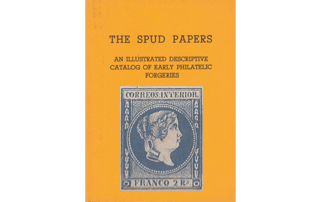Spud Papers – Phillippines
As these papers are written for the benefit of the inexperienced, we think that as the 5 Cuartos stamps of 1859, 1861, and 1863, only vary in detail, a few remarks concerning them will not be unacceptable in this place. Although there is considerable difference in the lettering, the simplest plan for our present purpose is to distinguish the issues by their dots. Of the first upon our list, there are four types, which were engraved in quaternary blocks, repeated several times upon the sheet; in these stamps there was no stop after CORREOS. According to Dr. Magnus, both this and the following emission have been reprinted, and in this view the learned doctor is supported by Mr. Overy Taylor (a most careful authority), and by other leading amateurs.
In the second type we have mentioned, CORREOS is followed by a large dot, so as to match the increased size of the inscription. The earliest 1863 issue (with smaller letters), has a single dot after CORREOS, and another, following value.
In the original of the forgery we are about to describe, there are two dots after CORREOS, and one after cs. There was only one die engraved for this, or for the two previously-named types respectively.
1863, Second Type, 5 c. From the slight knowledge which most young philatelists possess of the Philippine stamps, the counterfeit here given has doubtless had an extensive sale.
The following are the leading characteristics of the genuine:
- Letters of inscription small
- F of FRANCO at some little distance from the side of the label containing it
- A small stop after cs.
- Head is not badly engraved
- The lips are thick
- The nose slightly retrousse.
1864
The forgeries of this issue have had an extensive circulation through their deceptive appearance. All the values of the genuine, and of the forged, are from one matrix respectively, but the former are lithographed, whilst the originals are engraved.
3 1/8, 6 2/8, 12 4/8 and 25 Cent. PO. FE.
Genuine
There is the slightest depression under the chin. The hair over the ears is waved, with even undulations, and the back hair is clear and shows careful arrangement. The bow and ends of riband are distinct; the latter slant towards the side. Diadem is very distinct, and shows nine pearls and three jewels. Looped oval goes up close to the upper riband. Period before CORREOS rather below the center of the C, and slightly nearer to the end of riband than to the inscription.
Forged
There is a small, but marked depression beneath the Queen’s chin. The hair is waved at the side of the head, and three of the twists (if they may be so called) are wide and prominent; the ends of the riband below the back hair hang straight down, and are close together. The nape of the neck skews a kind of white loop, as thick above as below. The diadem is indistinctly drawn, and the pearls cannot be counted. The loop pattern surrounding the center is poorly done, and permits a considerable portion of the background to be seen between it and the upper riband, C of CORREOS is rather like a G. The period before the C of upper inscription is on a level with the middle of that letter, and nearer to it than to the end of the label.
From “The Spud Papers” by Atless, Pemberton & Earée, 1871-1881.

